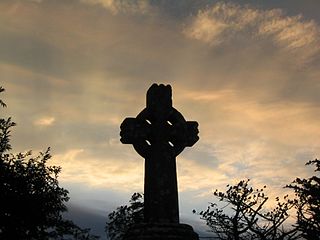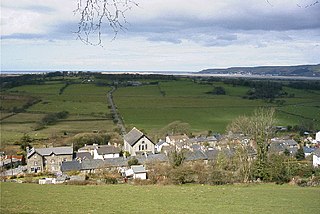Related Research Articles

Saint David was a Welsh bishop of Mynyw during the 6th century. He is the patron saint of Wales. David was a native of Wales, and tradition has preserved a relatively large amount of detail about his life. His birth date, however, is uncertain: suggestions range from 462 to 512. He is traditionally believed to be the son of Saint Non and the grandson of Ceredig ap Cunedda, king of Ceredigion. The Welsh annals placed his death 569 years after the birth of Christ, but Phillimore's dating revised this to 601.

Edward the Confessor was one of the last Anglo-Saxon English kings. Usually considered the last king of the House of Wessex, he ruled from 1042 to 1066.

Celtic Christianity is a form of Christianity that was common, or held to be common, across the Celtic-speaking world during the Early Middle Ages. Some writers have described a distinct Celtic Church uniting the Celtic peoples and distinguishing them from adherents of the Roman Church, while others classify Celtic Christianity as a set of distinctive practices occurring in those areas. Varying scholars reject the former notion, but note that there were certain traditions and practices present in both the Irish and British churches that were not seen in the wider Christian world.

Samson of Dol was a Cornish saint, who is also counted among the seven founder saints of Brittany with Pol Aurelian, Tugdual or Tudwal, Brieuc, Malo, Patern (Paternus) and Corentin. Born in southern Wales, he died in Dol-de-Bretagne, a small town in north Brittany.

Saint Petroc or Petrock was a British prince and Christian saint.

Saint Jacob of Nisibis, also known as Saint Jacob of Mygdonia, Saint Jacob the Great, and Saint James of Nisibis, was the Bishop of Nisibis until his death.
Cadfan ap Iago was King of Gwynedd. Little is known of the history of Gwynedd from this period, and information about Cadfan and his reign is minimal.

Saint Tydfil is the legendary dedicatee of Merthyr Tydfil, Wales. The old parish church of St Tydfil, Merthyr Tydfil is dedicated to her and is reputed to be the site of her death.

Saint Oudoceus (Latin) or Euddogwy (Welsh) is generally known as the third Bishop of Llandaff in South Wales. In reality he was probably a 7th-century bishop at Llandeilo Fawr. Wendy Davies puts his episcopal reign between about 650 and 700.

Llanfyllin is a market town and community in Powys, Wales. The town population in 2021 was 1,586 and the town's name means church or parish (llan) of St Myllin. The community includes the settlements of Bodfach, Ty Crwyn, Abernaint and several farms.

Melor was a 10th-century Breton saint who, in England, was venerated in Cornwall and at Amesbury Abbey, Wiltshire, which claimed some of his relics.

Saint Patrick was a fifth-century Romano-British Christian missionary and bishop in Ireland. Known as the "Apostle of Ireland", he is the primary patron saint of Ireland, the other patron saints being Brigid of Kildare and Columba. Patrick was never formally canonised, having lived before the current laws of the Catholic Church in these matters. Nevertheless, he is venerated as a saint in the Catholic Church, the Church of Ireland, and in the Eastern Orthodox Church, where he is regarded as equal-to-the-apostles and Enlightener of Ireland.

Llanafan Fawr is a village and community and ecclesiastical parish in the former cantref of Buellt (Builth) and historic county of Brecknockshire in Wales. It is now part of Powys. The community includes the former parish of Llanfihangel Bryn Pabuan.

Saint Afan of Builth was an early 6th-century Welsh bishop, martyr, and saint. His feast day is generally placed on 17 November, although the Demetian Calendar formerly used in southern Wales placed it on the 16th; it is no longer observed by either the Anglican or Catholic church in Wales.

Tre-Taliesin is a village in Ceredigion on the A487 road, 9 miles north of Aberystwyth, Wales, and 9 miles south of Machynlleth. It is in the parish of Llangynfelyn.
Nidan was a Welsh priest and, according to some sources, a bishop, in the 6th and 7th centuries. He is now commemorated as a saint. He was the confessor for the monastery headed by St Seiriol at Penmon, and established a church at what is now known as Llanidan, which are both places on the Welsh island of Anglesey. He is the patron saint of two churches in Anglesey: St Nidan's Church, Llanidan, built in the 19th century, and its medieval predecessor, the Old Church of St Nidan, Llanidan. Midmar Old Kirk in Aberdeenshire, Scotland, is also dedicated to him: Nidan is said to have helped to establish Christianity in that area as a companion of St Kentigern. St Nidan's, Llanidan, has a reliquary dating from the 14th or 16th century, which is said to house his relics.
Saint Peulan was a Welsh holy man in the early part of the 6th century, the son of Paulinus, a saint from south Wales who taught Saint David. A follower of Cybi, a saint associated with the island of Anglesey in north Wales, Peulan is commemorated in the dedication of the church he reportedly founded, St Peulan's Church, Llanbeulan, on Anglesey.
Elaeth was a Christian king and poet in Britain in the 6th century who is venerated as a saint. After losing his territory in the north of Britain, he retreated to Anglesey, north Wales, where he lived at a monastery run by St Seiriol at Penmon. Some religious poetry is attributed to him, as is the foundation of St Eleth's Church, Amlwch, also in Anglesey.
Tyfrydog was a Christian from north-west Wales in the fifth or sixth century, who was later venerated as a saint. He is said to have established a church in Anglesey, and although no part of the original structure remains, the current church is still dedicated to him. A nearby standing stone is said to be the remains of a man who he punished for stealing a bible from the church.

Saint Teilo, also known by his Cornish name Eliud, was a British Christian monk, bishop, and founder of monasteries and churches. He was from Penalun (Penally) near Tenby in Pembrokeshire, south Wales.
References
- ↑ David Farmer, The Oxford Dictionary of Saints, Oxford: (Clarendon Press, 1978), pp. 256–257.
- ↑ John Henry Newman, Lives of the English Saints, (London: Freemantle, 1901), vol. 3, pp. 40–41.
- ↑ C. Schreiber, The Mabinogion (Google eBook) (Рипол Классик, In the library of Jesus College, Oxford).page 471.